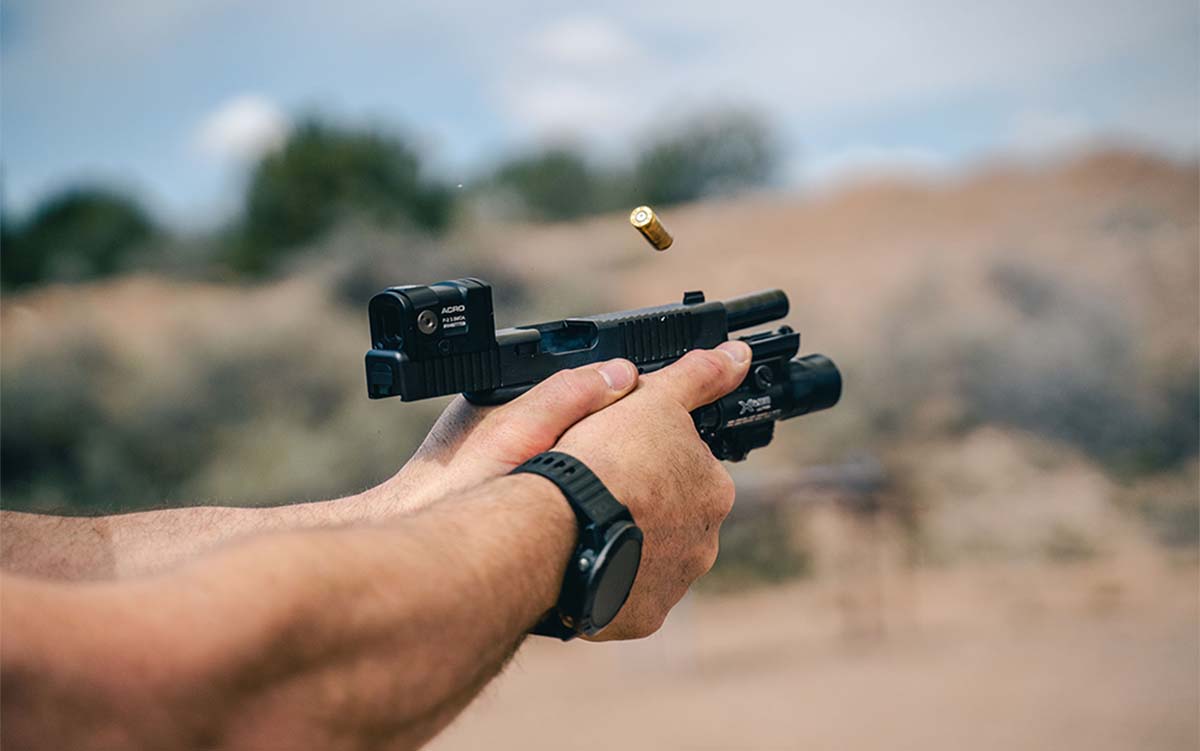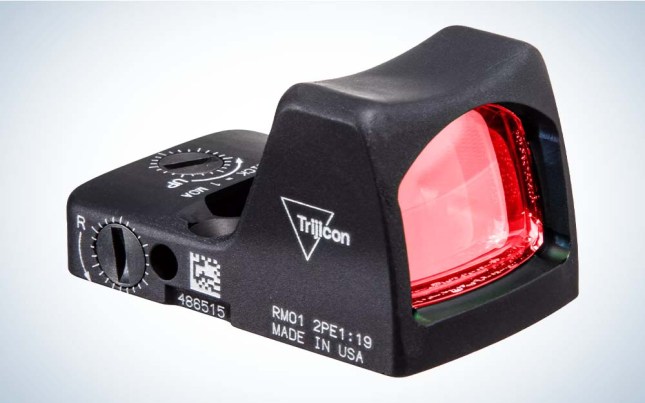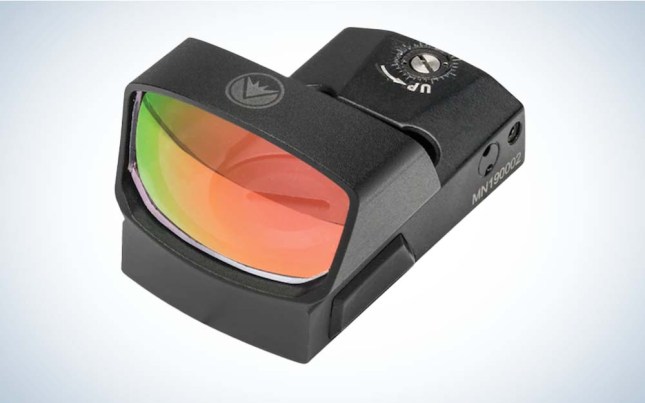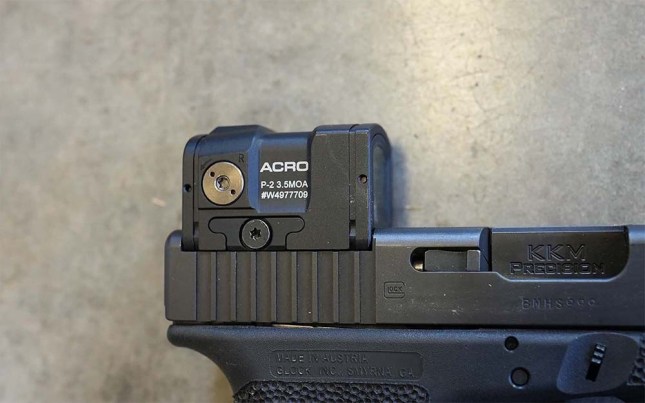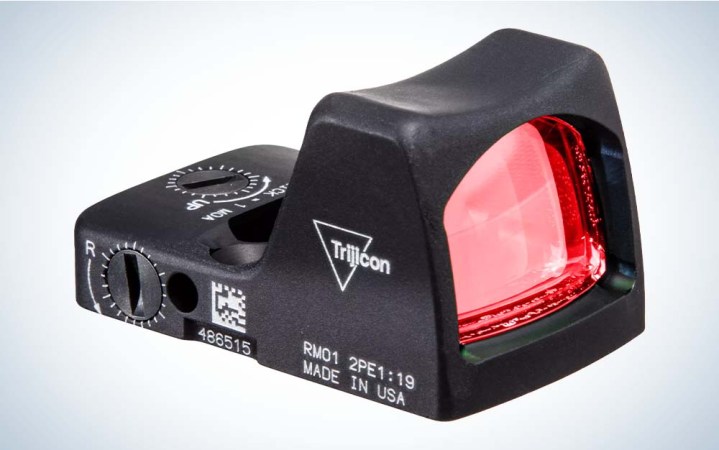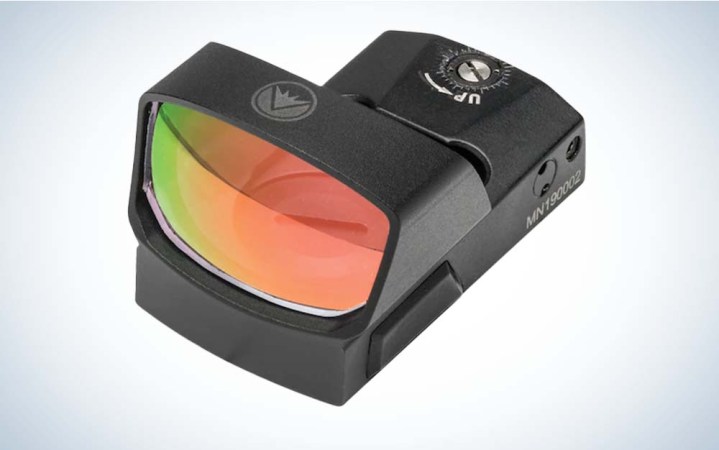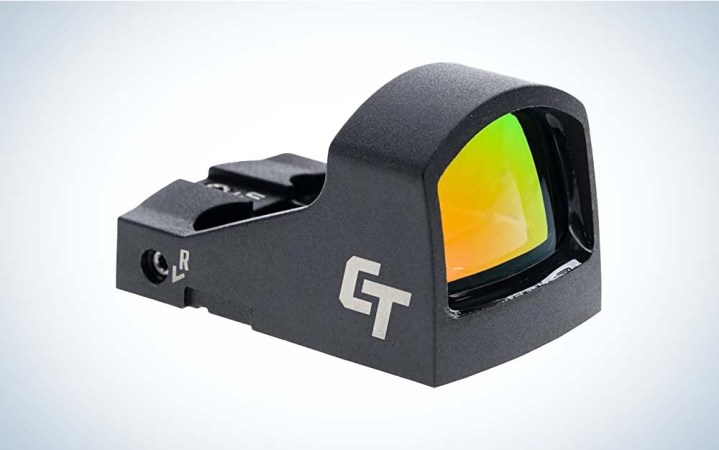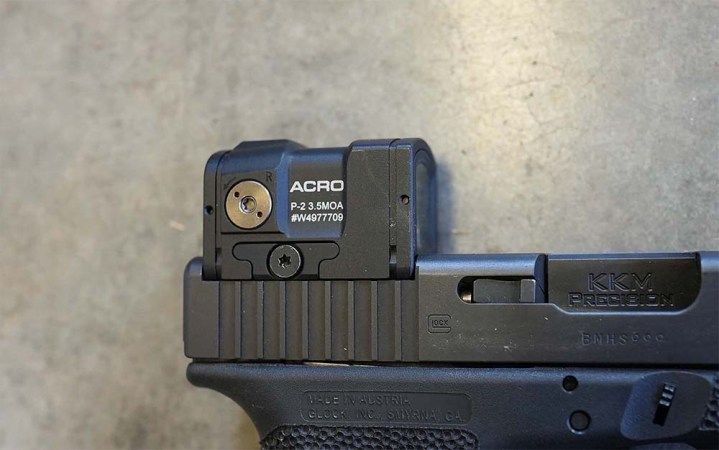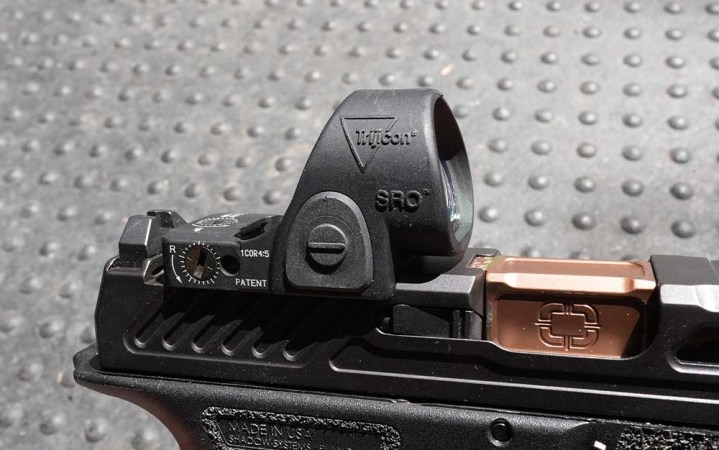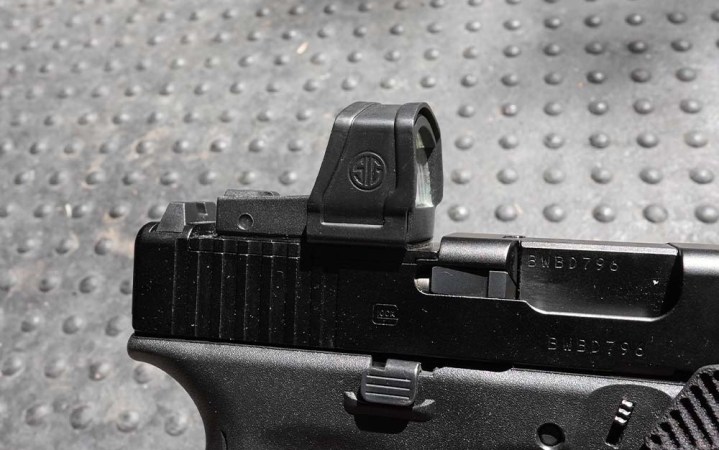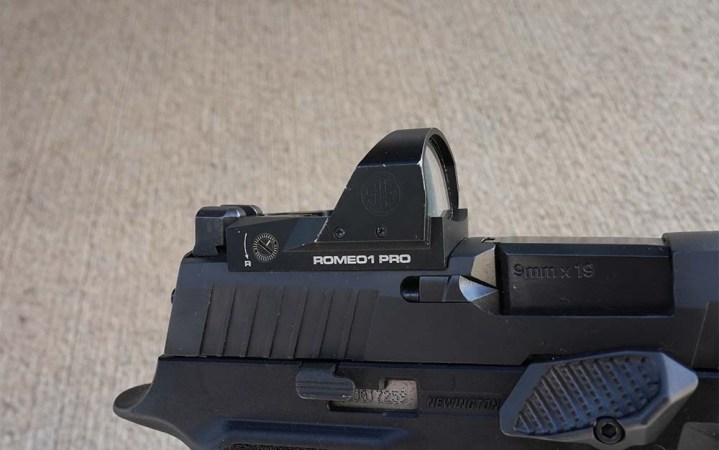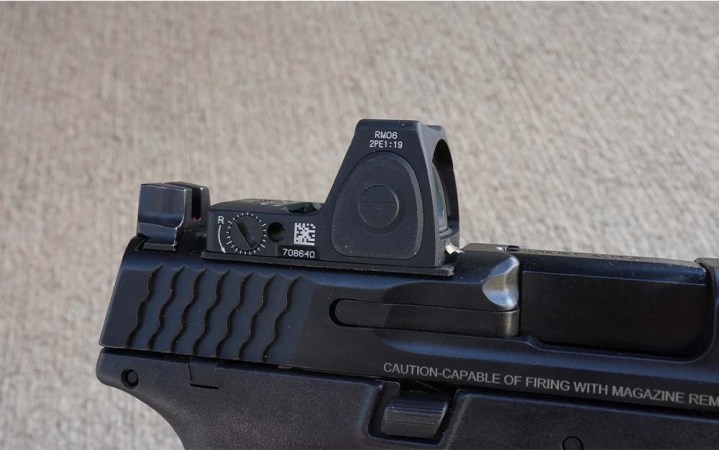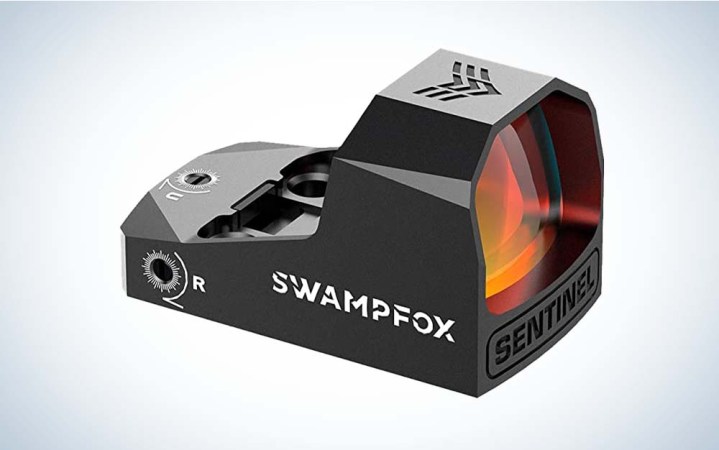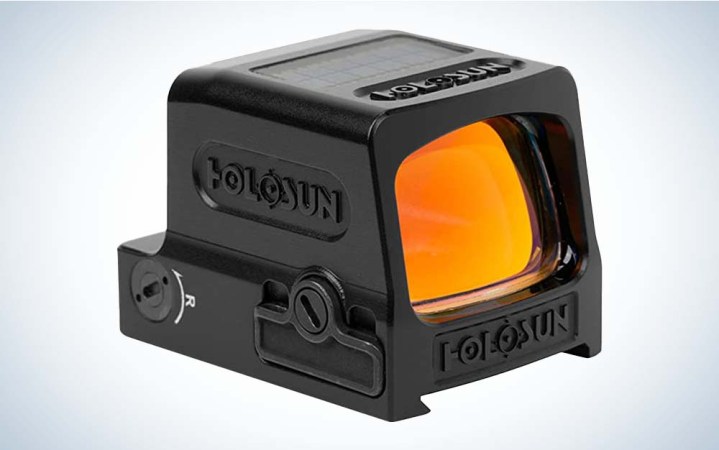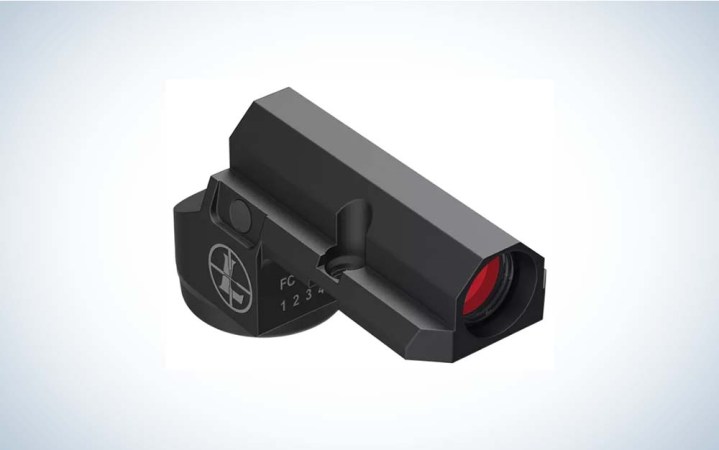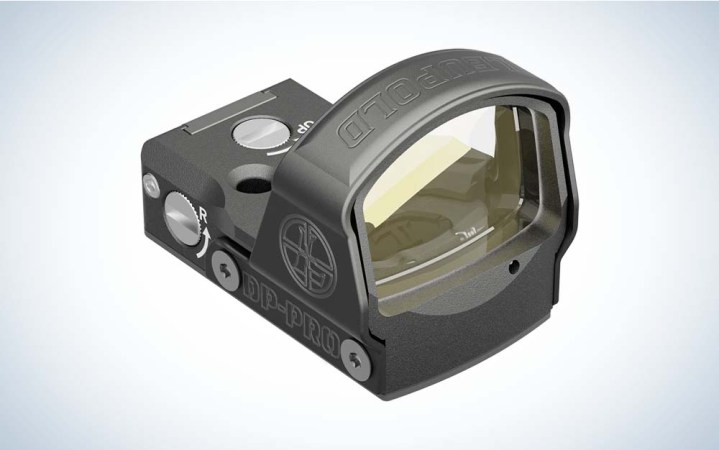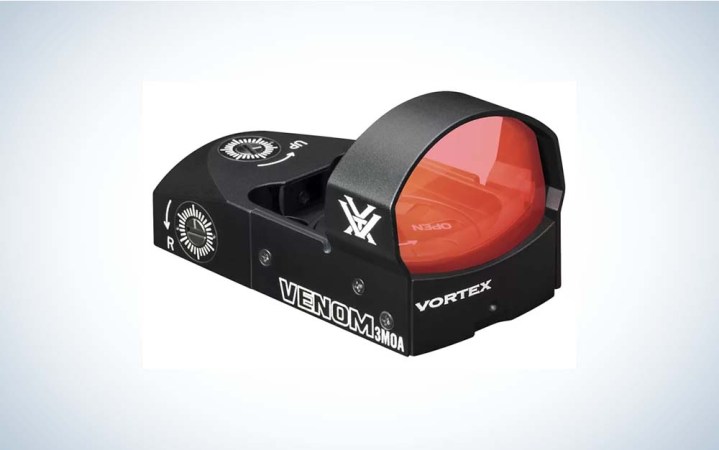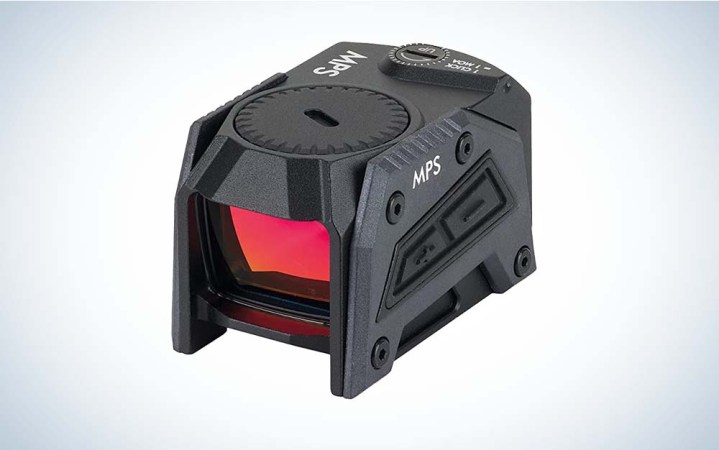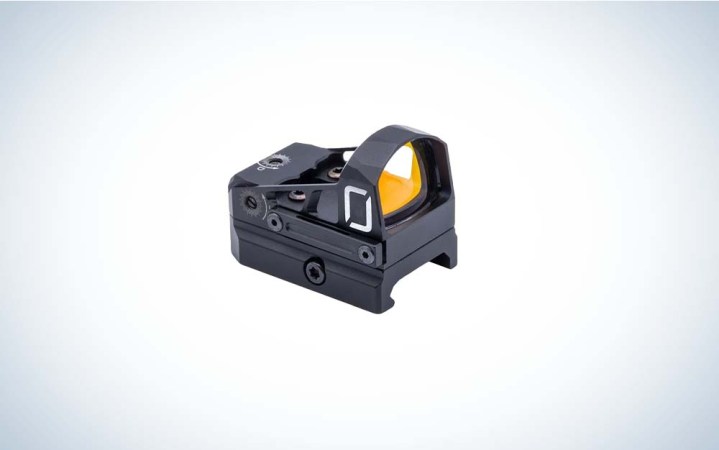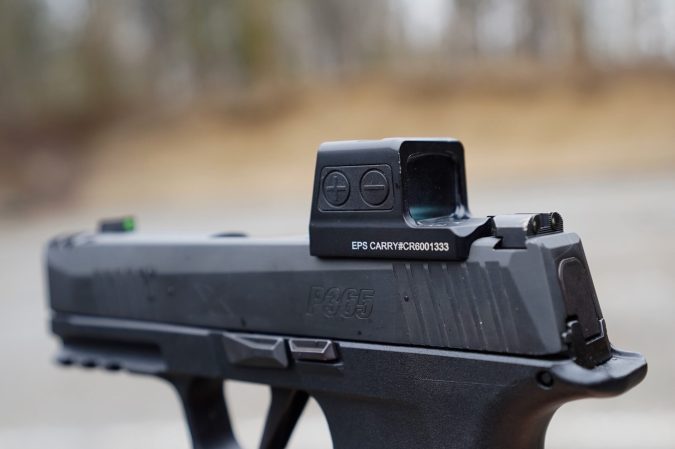We may earn revenue from the products available on this page and participate in affiliate programs. Learn More ›
Narrowing down a list of red dot sights is like determining the best flavor of ice cream. There are a ton of options out there. Most perform really well. Some are excellent. And, rarely, you’ll find a dud among the bunch.
I spent the last few months shooting and evaluating a host of red dots for this review. To help simplify things, I focused on red dots for handguns rather than open the field to those that are purpose-built for other firearms. Even with that fence around the project, it was an enormous undertaking. I’ll cover the Trijicon MRO, Bushnell Trophy TRS-25, Sig Sauer Romeo 5, and other red dot sights for carbines down the line.
One thing that’s clear is that the best red dot sights for you comes down to three main factors. First, what is your intended use? For recreational plinking at the range, it’s difficult to go wrong with any of the sights out there. But when your needs are more specific and demanding, the field narrows. For deep concealment, micro sights are the way to go, but they are more difficult to use than sights with wider windows. If you need your sight to endure extremely harsh environments, then you might need to choose an enclosed emitter unit, which tends to be a bit bulkier and more expensive than open emitters. If competing at a high level in shooting competitions is your thing, you won’t want to cut corners on objective lens size, dot sharpness, and other features.
This dovetails into the second factor, which is your budget. You can pick up a reasonable sight for about $100 or so, including one to mount on a defensive pistol that you’re counting on to potentially save your life. But as you spend more, you’ll get better feature sets, improved quality, and more sophisticated engineering. While you can spend more than $400 on a red dot—and some of the best run in that $400 to $600 range—there are a lot of great sights to be had between $300 and $400.
Lastly, there’s the X-factor of what looks cool to you. As the saying goes, what separates humans from the rest of the animal kingdom is our ability to accessorize. And when we add something new to any of our guns, most of us want it to look good. By that yardstick, some of the best red dot sights have a greater visual impact than others—and it doesn’t always correspond to the price.
- Best Overall: Trijicon RMR Type 2
- Most Versatile: Burris Fastfire 4
- Best Budget: Crimson Trace CTS-1500
- Best Enclosed Emitter: Aimpoint ACRO P-2
- Best for Competitive Shooting: Trijicon SRO
- Lightest Weight: Sig Sauer Romeo Zero Elite
- Great Field of View: Sig Sauer Romeo1 Pro
- Best High-End Concealed Carry Sight: Trijicon RMRcc
- Best Micro: Swampfox Sentinel M
- Best Shotgun/Pistol Crossover: Holosun HE509T-RD
- Best Low Profile: Leupold DeltaPoint Micro
- Best for Fast, Close Shooting: Leupold DeltaPoint Pro 6 MOA
- Excellent All-Around Sight: Vortex Venom
- Ultra-Rugged: Steiner MPS
- Best for an AR-15 Pistol: USO DRS 2.0
- Best RMSc Enclosed Emitter: Holosun EPS Carry
Best Red Dot Sights: Reviews & Recommendations
Best Overall: Trijicon RMR Type 2
Key Features
- Weight: 1.2 ounces
- Objective Lens Size: .83 x .63 inches
- Reticle: 1, 3.25, or 6 MOA dot
- Adjustment: Eight settings, two for NV
- Battery Life: 4 years
- Battery: CR 2032
Pros
- Built for hard use
- Good ergonomics
- Great engineering
Cons
- Expensive
The Trijicon RMR Type 2’s distinctive features set it apart from the rest of the field and justify its lofty price tag. After spending months testing this whole field of red-dots, I had to pick one as the winner. It’s a Sophie’s Choice scenario for sure—but rules are rules, and the Trijicon RMR Type 2 got the nod as the overall best red dot sight.
For starters it’s difficult to find anything to criticize about this sight, other than perhaps its price. But you get what you pay for, and when you slap your money down for one of these, you’re getting a hell of a unit.
The RMR sights have a couple of distinctive features compared to the rest of the field. One is the drain holes on either side of the housing that keep water and other debris from collecting around the emitter. The other is the curious shape of the housing, with its concave top. Both these elements hint toward the end users that Trijicon had in mind when developing the sights: serious professionals who rely on them for their lives.
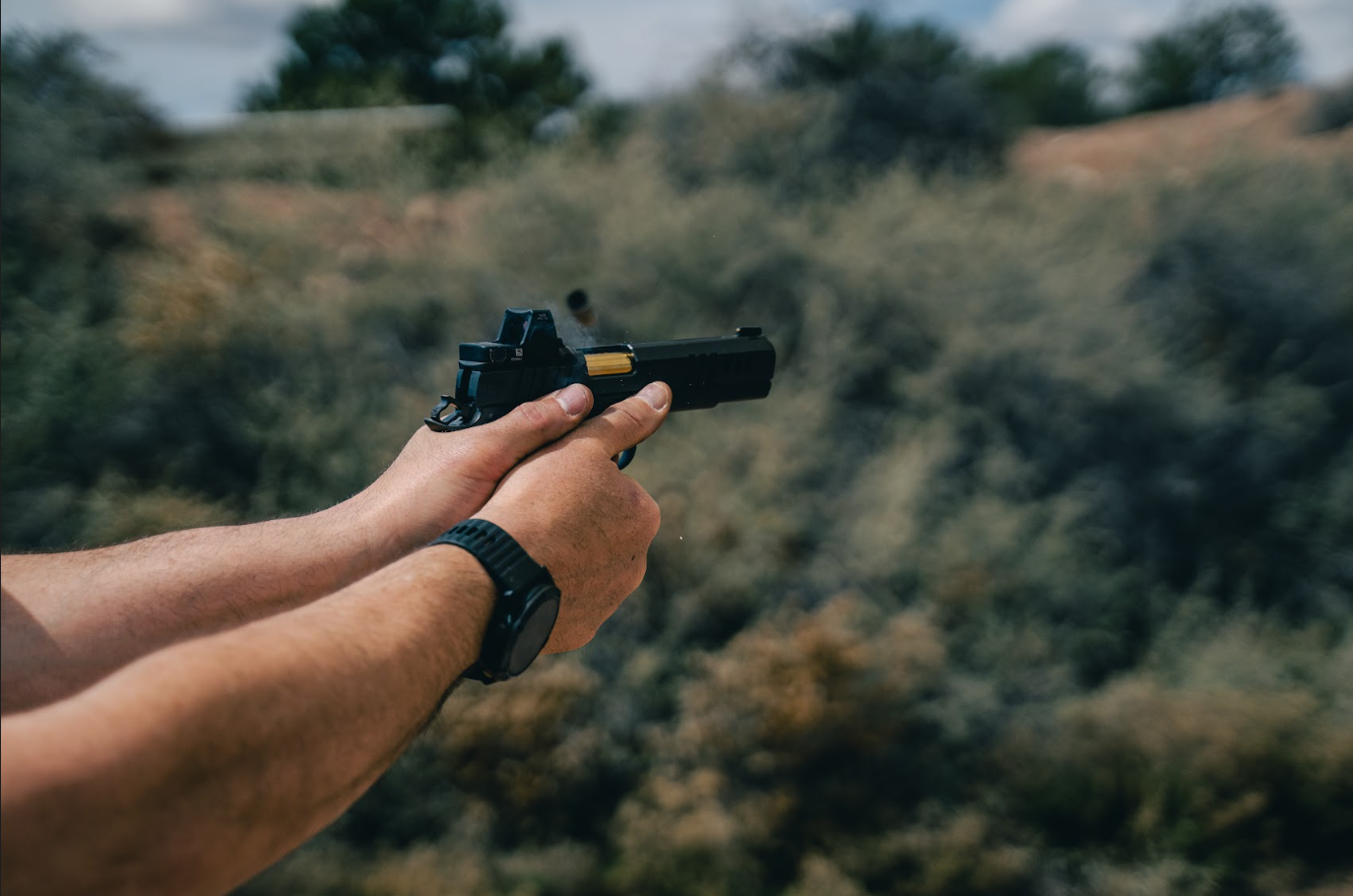
The utility of the drain ports is obvious. Whether Marines are on patrol in a swamp or a Special Operations unit is using scuba gear, they want their sights to be clear and good to go at all times. The shape of the housing mitigates hard impacts and protects the glass from damage. The Trijicon RMR Type 2 is rated waterproof to 20 meters (66 feet).
There are a couple dozen different variants of the Type 2 to pick from with various mounting systems and dot sizes. It can be had with 1, 3.25, or 6.5 MOA dots. Mine, a 3.25 MOA dot, is bright and crisp. The unit has minimal optical distortion (though the glass does have a noticeable blue tinge), eight brightness settings to pick from (including two for night vision), and a four-year run time from a CR 2032 battery. If desired, the sight can be set to an automatic mode that adjusts reticle brightness based on ambient light.
If you’re looking for a pistol or small arms sight that can do it all—personal protection, concealed carry, target shooting, hunting—the RMR Type 2 is it.
Most Versatile: Burris Fastfire 4
Key Features
- Weight: 1.7 ounces
- Objective Lens Size: 27x18mm
- Reticle: Four user-selectable options
- Adjustment: 3 brightness levels
- Battery Life: 26,000 hours
- Battery: CR 1632
Pros
- Multiple reticles
- Versatile design
Cons
- Some optical distortion
The Burris Fasfire 4 is the Swiss Army knife of red-dot sights. With the push of a button on the right side of the unit’s housing, you can cycle through four reticles. The reticles include a 3 MOA dot, an 11 MOA dot, an 11 MOA dot surrounded by a 50 MOA circle, and a 3 MOA dot surrounded by a 50 MOA circle with the addition of two “wings” that effectively form a horizontal crosshair.
Each of these reticles has useful applications. The 3 MOA dot is good for precise shot placement and general handgun use. The 11 MOA dot is good for bright lighting conditions and would work well for turkey hunters and slug-gun hunters. The 11 MOA with a circle is good for personal defense and CQB scenarios, and the 3 MOA circle with wings can handle close and mid-range shooting. It can also be a good option for wingshooting as well. The intensity of these reticles is controlled by a button on the left side of the unit, which has three levels of brightness.
As the late-night TV pitchmen say, but wait, there’s more! The Fastfire 4 is also the only sight in this roundup that converts from an open to closed emitter design. It comes with an environmental shield that screws on to the back of the unit and encloses the emitter. While this won’t make the Fastfire waterproof against submersion, it will prevent rain, snow and dirt from clogging the LED.
The Fastfire 4 comes with a cross-slot base so you can easily screw it on to a Weaver or Picatinny pattern mounting surface. With the weather shield installed the weight of the unit is right at 2 ounces. With the base removed the Fastfire has a Docter/Noblex footprint, so with an adapter you can mount it to a handgun and it won’t be too bulky.
The wide objective lens makes reticle acquisition easy, but the glass does have noticeable optical distortion.
Best Budget: Crimson Trace CTS-1500
Key Features
- Weight: .65 ounces
- Objective Lens Size: 21x15mm
- Reticle: 3 MOA dot
- Adjustment: Automatic
- Battery Life: 20,000 hours
- Battery: CR 2032
Pros
- Simple design
- Affordable
- Light weight
Cons
- No frills
Not only is the Crimson Trace CTS-1500 budget friendly, but it could also win an award as the most idiot-proof ultra-compact red dot sight on the market. The 3 MOA dot on the CTS-1500 is a perfect size for general defensive pistol use, and thanks to the unit’s polymer frame it tips the scales at a scant .65 ounces even with the CR 2032 battery on board.
The CTS-1550 doesn’t come with much in the way of bells and whistles, but it does serve its primary function well. The dot auto adjusts to lighting conditions for hassle free use and the battery has a published run time of 20,000 hours. I’ve had one mounted on my Kimber Mako R7 for nearly a year and it’s still going strong.
One nice element of the CTS-1550 is the notch cut into the rear of the housing, which allows the shooter to more easily co-witness with their iron sights. This can help with dry-fire training while getting used to working with a handgun-mounted red dot and also serves as a useful backup should the sight fail for some reason.
It has a J-Point / RMSC footprint, allowing it to attach to any compatible pistol. Since this is a micro compact, the dot can be a bit trickier to pick up in the objective lens, but that’s the tradeoff for its high degree of concealability.
The lack of a gasket between the unit and mounting surface means you need to be careful when using it in wet conditions as moisture can seep into the battery compartment. It’s an easy thing to check, however, by removing the two fasteners that secure the sight to the pistol. You’ll just need to check zero after remounting the sight. Fortunately, adjusting the point of impact is a simple and painless process.
Best Enclosed Emitter Red Dot: Aimpoint ACRO P-2
Key Features
- Weight: 2.1 ounces
- Objective Lens Size: 15x15mm
- Reticle: 3.5 MOA dot
- Adjustments: 10 settings, four for NV
- Battery Life: 50,000 hours
- Battery: CR 2032
Pros
- Extremely rugged
- Great optical clarity
- Excellent ergonomics
Cons
- Pricey
The Aimpoint ACRO P-2’s enclosed frame and waterproofing capabilities make this a rugged and reliable red dot. When I was putting together a new handgun for bear protection, I topped it with this sight. The Aimpoint ACRO P-2 checks all the boxes I needed and excels in terms of reliability and survivability.
The main virtue of an enclosed emitter is that it is protected from the environment. I spend a lot of time in grizzly country, both in the mountains and in low-lying river bottoms. Between the snow that’s typical at elevation and the mud and debris that’s part of any river system, there are a lot of ways for a red dot to get clogged with gunk. The ACRO P-2 has flat windows on either side of the unit that can easily be wiped with a shirt sleeve to clear the glass.
The ACRO also has best-in-class waterproofing: it is submersible to 35 meters (115 feet) so you can dunk it without harming it in any way. The P-2 also has much improved battery life over the original ACRO and can deliver up to five years of service on a single CR 2032.
The 3.5 MOA dot has round, crisp edges, though when the intensity level is jacked up to the max (there are 10 settings, four of which are for night vision), the dot has a fair bit of blooming. On the plus side, there isn’t any lighting situation where the ACRO’s dot will wash out. The buttons that control the dot intensity give very positive feedback, which allows them to be manipulated while wearing gloves.
The optical clarity of the unit is among the best in the field. There is very little color distortion and no optical distortion while looking through the sight. Picking up the dot and recovering it while shooting is a snap. It is very forgiving.
All this performance, however, comes at a cost. The ACRO P-2 is among the most expensive red dots out there, but it is a serious professional-grade tool that is well worth it.
Best for Competitive Shooting: Trijicon SRO
Key Features
- Weight: 1.6 ounces
- Objective Lens Size: 26mm
- Reticle: 1, 2.5 or 5 MOA dot
- Adjustment: 8 brightness levels, two for night vision
- Battery Life: 3 years
- Battery: CR 2032
Pros
- Generous sized objective lens
- Great ergonomics
- Tough
Cons
- Spendy
The Trijicon SRO’s 26mm objective lens makes it easy to reacquire the dot during rapid shooting competitions. Looking through the Trijicon SRO is like staring out of a large picture window with mountain views. It’s a thing of beauty. The generously sized objective lens measures 26 mm in diameter making it easy to find and reacquire the dot during rapid shooting. That quality is a big part of the reason why the SRO is my top choice for competition.
In addition to that is the bomb-proof construction and top-notch engineering of all Trijicon’s red dot offerings.
The SRO is offered with three sized dots depending on your needs: 1 MOA, 2.5 MOA, or 5 MOA. I opted for the 2.5 MOA model, which strikes a great balance between size and precision and handles any shooting chore well.
For a larger sight, the SRO manages to sit relatively low on the slide. That makes sighting through the window that much faster and helps the sight co-witness with irons more easily.
The SRO has a tiny bit of optical distortion, but not enough to detract from the sight’s performance. In fact, with its large objective lens, the SRO handled tracking and target transitions better than any other red-dot in the test.
The ergonomics on the unit are fabulous as well. The windage and elevation adjusters have medium-sized slots that can accommodate a regular screwdriver bit or thin coin and offer positive feedback with each click. The sight has 150 MOA of w/e travel with each click moving the sight 1 MOA. The battery tray is easy to access and doesn’t have to be removed from the pistol when putting in a new one.
It has eight brightness levels, two of which are for night vision. The sight can be set to automatically adjust brightness levels as well if you choose.
And, for those of you who want to take your guns underwater, the SRO is rated waterproof to three meters (10 feet) and has drain holes in the side of the housing.
Lightest Weight: Sig Sauer Romeo Zero Elite
Key Features
- Weight: .5 ounces
- Objective Lens Size: 20mm
- Reticle: 3 MOA dot
- Adjustment: Eight settings
- Battery Life: 20,000 hours
- Battery: CR 1632
Pros
- Light weight
- Good value
Cons
- Inconvenient control button
The Romeo Zero Elite is a wisp of a red dot, tipping the scales at a dainty 0.5 ounce. Its compact profile makes it a good choice for smaller concealed carry handguns. I’ve been running a Romero Zero Elite on a Glock 19 for a while now and it has stood up to some rough use and a lot of rounds.
It’s a basic unit with a 3 MOA dot with eight brightness levels. It’s also offered with a 2 MOA dot within a 32 MOA circle for those who want a larger reticle. A small button just behind the objective lens controls the unit. While unobtrusive, the button is a little hard to reach, especially if you have sausage fingers, and a bit of a pain to manipulate. If my fingers were dirty—from doing a lot of shooting, say—I had difficulty adjusting the brightness without getting a greasy smear on the inside of the objective lens. Not a deal killer by any means, but it is pesky.
Other than that, I had no complaints with the Romeo Zero Elite. The optical quality of the sight is pretty good. It has a metal shield you can install to give the polymer-framed unit more protection if you like. The zero is easy to adjust via the recessed windage and elevation controls that use a tiny hex key wrench.
Another thing in its favor is its affordability. It’s one of the best red dots for the money. With a CR 1632 on board, it delivers up to 20,000 hours of run time.
Great Field of View: Sig Sauer Romeo1 Pro
Key Features
- Weight: 1 ounce
- Objective Lens Size: 28x17mm
- Reticle: 3 or 6 MOA dot
- Adjustment: 12 settings, 2 for NV
- Battery Life: 20,000 hours
- Battery: CR 1632
Pros
- Very shootable
- Good ergonomics
Cons
- Not rated for 10mm Auto
The Sig Romeo1 Pro is a great all-around red-dot sight that can function well for either personal protection or competition/recreational shooting duties. Its generous window dimensions — 28mm wide and 17mm tall — make it one of the faster red dots to shoot. It’s easy to pick up the dot on the initial gun presentation and reacquire it under recoil.
I’ve been using a Romeo1 Pro on my Sig P320 for a couple years, and it has served me well. The housing is made of machined aluminum and has withstood daily use and abuse with only a couple scratches to show for it. The aluminum forms a bit of a lip in front of the sight’s window, so you can bang the housing against hard surfaces without touching or damaging the glass. The molded aspheric glass lens is multi-coated to reduce distortion. The optical clarity of it is very good, though the image does have a slight blue tinge, which is common with many reflex sights.
On the unit’s left hand side are two buttons to pick among the Romeo1 Pro’s 12 brightness settings, two of which are for night vision. The sealed electronics on it are rated to IPX7 waterproofness, which means it can be submerged to 1 meter for 30 minutes.
The battery compartment is located right behind the object lens and can be opened with a slot-head bit or coin. This allows the shooter to change batteries without messing with the pistol’s zero. It uses a CR 1632 and has a published run time of 20,000 hours. To conserve battery life, the unit will power down after a period of time and turn back on when moved.
The sight has a whopping 100 MOA of windage and elevation travel. If you find yourself needing all that, you might want to double check and see that your pistol’s barrel isn’t bent. The sight uses two small slot-head adjusters that move the dot 1 MOA with each click.
The Romeo1 Pro is also available with a 6 MOA dot. It’s worth noting that this particular unit isn’t rated for 10mm Auto use. For that you’ll want to upgrade to Sig’s Romeo2 1x30mm enclosed emitter.
Best High-End Concealed Carry Sight: Trijicon RMRcc
Key Features
- Weight: 1 ounce
- Objective Lens Size: 13mm
- Reticle: 3.25 or 6 MOA dot
- Adjustment: 8 brightness levels, 2 for NV
- Battery Life: 4 years
- Battery: CR 2032
Pros
- Extremely rugged
- Smart electronic features
Cons
- Small window
- Expensive
The Trijicon RMRcc is a beautifully engineered micro red dot with best-in-class ruggedness, and a smart suite of electronic functionality. It’s an expensive, professional-grade sight designed to take you to hell and back, should the need arise. The RMRcc comes with dots that subtend either 3.25 or 6.5 MOA. For a dedicated defensive pistol, the 6.5 MOA dot would be hard to beat, though a 3.25 MOA dot makes the sight a bit more versatile for precision work.
It has eight brightness modes that can be cycled through with the generously sized buttons on either side of the aluminum housing. The top level of brightness has a retina-burning intensity that allows the sight to function well in the brightest possible conditions. The bottom two are meant for night vision gear.
The electronics allow the user to either lock in a particular brightness level, which is useful for competition and certain hunting scenarios, or it can operate in an automatic mode where the reticle brightness rises and dims in relation to the available ambient light.
The unit is sealed against the environment and is submersible to 20 meters (66 feet), which is one of the reasons that many armed professionals gravitate toward it and its bigger brother, the RMR Type 2. It comes with drain holes on the side of the housing so that water drains away.
The window is a little cramped, which makes the sight a little harder to acquire (and reacquire) while shooting. That means it might not be the best pick for someone with beginner-level skills who isn’t as committed to mastering the platform.
Changing the battery requires the user to remove the sight from the pistol, so checking and possibly readjusting the sight’s zero will be necessary.
The adjustments on the Trijicon RMRcc are more coarse than many other units, with each tick mark moving the point of impact 3 MOA. At 25 feet, that amounts to about ¼ inch shift per click. The slots in the windage and elevation adjusters can accommodate standard size slot-head bits easily or even the back edge of a knife, so no special tools are needed.
This sight uses the Trijicon RMRcc mounting standard.
Best Micro: Swampfox Sentinel M
Key Features
- Weight: .82 ounces
- Size 16x16mm window
- Reticle 3 MOA dot, manual adjustment 10 levels
- Adjustment: Manual
- Battery Life: 12,000 hours. active, 50,000 hours stand-by
- Battery: CR 2032
Pros
- Sleek, minimalistic profile
Cons
- Some optical distortion
Competition among micro-sized red dots is stiff as there are a lot of good options to choose from. In this crowded field, the Swampfox Sentinel M strikes an attractive balance between features, optical quality, and price. Like other micros, the Sentinel M has a minimalistic profile that will fit well on smaller pistols with narrow slides. Among those are the Glock 43X and Glock 48 MOS, Sig P365XL, Springfield Hellcat OSP, Canik Elite SC, S&W Shield 2.0 Optics Ready, Walther PPS M2 Optics Ready—basically any pistol with an RMSc footprint can accommodate one.
Shooters will argue about the merits of exposed controls on red dots for concealed guns, but I like the easy-to-use buttons on either side of the Sentinel’s aluminum housing, which cycle through 10 different brightness settings. It also has well-marked windage and elevation dials that adjust with the tool that ships with the unit or a small slot-head driver.
It runs on a CR 2032 battery and has a published run time of 12,000 to 50,000 hours. The Sentinel M comes with smart electronics. It will go into battery saving mode after four minutes of inactivity but reilluminates when the unit detects movement. If you turn the unit off, which you do by holding down the “-” for three seconds, the Sentinel returns to your previous brightness setting when powered back on.
Like other micros, the Sentinel M has an exposed battery compartment on the underside of the housing. To help seal it from the elements, it ships with a thin rubber gasket that you place between the base of the sight and the slide. That provides it with an IPX7 waterproof rating (one meter for 30 minutes).
It’s thoughtful touches like these that make the Sentinel M an appealing choice and one of the best red dot sights of its type.
The unit’s optical quality is good — not great — but certainly up to the standards of other micros. And the quality of the dot is clean and sharp enough for the defensive pistol work that it is designed for.
Not that aesthetics are the most important consideration for a micro red dot, but they are a consideration. The finish on the metal, the sharp lettering on the logos, and the attractive shape of the housing are nice elements too.
Best Shotgun/Pistol Crossover: Holosun HE509T-RD
Key Features
- Weight: 2.25 ounces
- Objective Lens Size: 16x23mm
- Reticle: 2 MOA dot or 2 MOA dot in 32 MOA circle
- Adjustment: Automatic or manual with 12 levels to choose from.
- Battery Life: 12,000 or 50,000 hours
- Battery: CR 1632
Pros
- Dual reticle options
- Enclosed emitter
- Solar backup power
Cons
- Some image distortion
- Heavy
The dual reticle options on the HE509T-RD make it a viable option for both pistols and shotguns and even rifles, for that matter. Holosun has a devoted following among many top-level competitors who run red dots on their guns. The company makes no-nonsense task-driven sights that are rugged and incorporate useful technology at reasonable prices. Many other brands of red dots are manufactured by Holosun, in fact, which is a testament to their quality.
The Holosun HE509-T is an enclosed emitter in a titanium housing. The titanium has a few benefits, including reduced weight, improved strength when compared to aluminum, and resistance to saltwater corrosion.
It has two user-selectable reticle options, a 2 MOA dot or a 2 MOA dot surrounded by a 32 MOA circle with four “positioning points” located at 3-, 6-, 9-, and 12-o’clock. Depressing the “-” button for three seconds toggles between the two. When running the circle/dot reticle, the HE509-T will last for 12,000 hours, while running the dot alone bumps that to 50,000 hours.
These reticles make the HE509T useful for both pistol and shotgun applications, and rifles too, for that matter. It’s a fine red dot for shotguns, especially with the reticle on the circle/dot setting.
The sight can be operated in two modes: automatic and manual. On automatic, the sight adjusts the intensity of the reticle based on ambient lighting conditions, while in manual the shooter sets the reticle brightness. In manual mode, the sight has 12 levels to choose from, two of which are for night vision.
About the only issue with the sight is its optical quality, which has a bit of distortion at the edges.
The sight uses a CR 1632 battery that is in a tray that slides into the right side of the unit and is secured by a single slot-head fastener. This allows the battery to be changed without removing it from the firearm. When the battery runs low the reticle slowly blinks to let you know, which is a nice feature.
Despite its titanium housing, the emitter weighs 2.25 ounces, making it one of the heavier in the roundup. The HE509T comes in two versions, with either a red or green reticle. The green bumps the price by about $35. It has its own mounting dimensions but comes with a RMR pattern plate and an adapter for the Glock MOS system.
Read Next: Best Red Dots for Turkey Hunting
Best Low Profile: Leupold DeltaPoint Micro
Key Features
- Weight: 1 ounce
- Objective Lens Size: 9mm
- Reticle: 3 MOA dot
- Adjustment: Eight settings
- Battery Life: 30,000 hours
- Battery: CR 1632
Pros
- Low profile
- Enclosed emitter
Cons
- Limited to Glocks and Smith & Wesson M&P pistols
The DeltaPoint’s low profile makes it an excellent option when deep concealment is desired. When the DeltaPoint Micro appeared, it challenged the conventional wisdom concerning micro red dot sights. It mounts on the rear sight dovetail the pistol and most of the electronics hang off the back of the slide. The sight itself is a small tube—only 9mm in diameter—that acts like a ghost ring with respect to the pistol’s front sight.
It’s an ingenious design, but one that shooters were a bit leery of because of the small sight aperture. Would it be difficult to pick up the dot on presenting the pistol and after recoil?
Those are valid questions. The answer is that the system works very well. Because the DeltaPoint Micro employs the geometry of the pistol’s iron sights, it is very easy for the shooter’s eye to align with the optic. As a bonus, should the sight go down, the tube can be used as a ghost ring with the front sight.
Among current red dots there isn’t another out there that has such a low profile, making the DeltaPoint Micro ideal for carry where deep concealment is desired and one of the best red dot sights for this purpose.
The system isn’t without its limitations however. The biggest is that it’s currently only available for two types of pistols: the Smith & Wesson M&P and the Glock. Of course, those two account for a huge chunk of the worldwide handgun market, so there’s no lack of potential customers. But if you rock a different model, the Micro isn’t an option for you at the moment.
The other issue is that installation is a bit more involved than with many other red dots, as you have to remove the rear sight to gain access to the dovetail. That’s not a huge deal, but it isn’t as simple as just screwing it onto a mounting plate.
One thing I like about the Micro is that it is an enclosed emitter, so you don’t have to worry about dust and lint getting into the works and gumming it up.
The sight has a 3 MOA dot. I don’t know if it is a function of the sight’s design, but this dot isn’t as sharp and round as other DeltaPoint offerings, but it isn’t so much of an issue that it affects how the sight performs.
The elevation adjustments on it are generous. The DeltaPoint Micro has 100 MOA of elevation and 180 MOA of windage on tap. The point of impact adjusts via two small Allen key fasteners that are recessed into the housing. It has eight brightness settings that the user toggles through with the large button on the battery housing.
Best for Fast, Close Shooting: Leupold DeltaPoint Pro 6 MOA
Key Features
- Weight: 2 ounces
- Objective Lens Size: 20mm
- Reticle: 6 MOA dot
- Adjustment: 8 settings
- Battery Life: 1,600 hours
- Battery: CR 2032
Pros
- Excellent optical quality
- Large, bright aiming point
- Convenient battery compartment
Cons
- Expensive
- Sits high on the pistol
When it comes to getting lead on steel and paper quickly, no sight performed better in the test than the Leupold DeltaPoint Pro 6 MOA. Its large, bright dot and exceptional optical clarity make it a no-brainer for this kind of shooting. Like all Leupold DeltaPoint’s, this model is wonderfully engineered. The toolless battery compartment/adjustment button is convenient and clever. Pushing on the button allows the shooter to cycle through eight different brightness settings.
The coin-slot windage and elevation adjustments have 60 MOA of travel. They adjust in 1 MOA clicks and give excellent tactile feedback when turned.
The battery life figures that Leupold gives are much lower (and more realistic, to be honest) than you’ll see with other sights, but it’s worth keeping the dot brightness to a lower setting or making a point to turn off the sight when not in use to get more from the battery.
To harden the sight, Leupold encloses it in a metal shield that wraps over the optic. This bumps the weight to 2 ounces, making it one of the heavier open-emitter sights in the test.
Excellent All-Around Sight: Vortex Venom
Key Features
- Weight: 1.1 ounces
- Objective Lens Size: 20 mm
- Reticle: 3 or 6 MOA dot
- Adjustment: 10 settings
- Battery Life: 30,000 hours
- Battery: CR 1632
Pros
- Jack of all trades
Cons
- Humdrum styling
The Vortex Venom is one of the most popular red dot reflex sights currently offered—and for good reason. It’s a solid, all-around red dot that works well on handguns, shotguns, AR-15s, and other rifles. The Venom doesn’t bring any fancy technology to the party, but what it does have is a generous window, a crisp 3 or 6 MOA dot that can be adjusted to any of 10 brightness levels, controls that are easy to manipulate and a solid housing made of aluminum that can take a beating.
You can also switch the sight to “auto” mode where it adjusts the reticle brightness according to the ambient light.
The slot-head windage and elevation adjusters are easy to dial in. The sight has 130 MOA of elevation travel on tap and 100 MOA of windage elevation, with each click of the adjusters moving the POI by 1 MOA.
One feature that has attracted a lot of shooters to Vortex’s products is their generous no-questions-asked warranty program. Basically, if you manage to break it, Vortex will replace it. Critics say that’s borne of necessity because the company doesn’t make optics as durable as others. Be that as it may, however, the fact that Vortex does stand behind their offerings and they’ve earned a lot of loyal customers because of it.
Ultra-Rugged: Steiner MPS
Key Features
- Weight: 2 ounces
- Objective Lens Size: 20x16mm
- Reticle: 3.3 MOA dot
- Adjustment: 8 levels (2 NV)
- Battery Life: 13,000 hours
- Battery: CR 1632
Pros
- Rugged
- User friendly
Cons
- Can be tricky to mount on different platforms.
The Steiner MPS is a rugged enclosed emitter that also has exceptional aesthetics. The MPS is arguably the sexiest pistol reflex sight out there. It has head-turning futuristic lines that visually set it apart from this crowded field of the best red dot sights. For that reason, any gun owner who values the aesthetic impact of their gun will want to consider the MPS.
But this sight is more than a pretty face. It’s a rugged and capable enclosed emitter with user-friendly ergonomics and a distortion-free sight picture. And, while not cheap, it runs about $100 less than the Acro P-2, so it has that going for it as well.
The 3.3 MOA dot is round and crisp—one of the sharpest in the test. The MPS has eight brightness settings on tap (two for night vision), that are actuated by the “+” and “-” buttons on the unit’s left side.
The MPS’s battery compartment sits on top of the metal housing and takes a CR 1632 battery that provides enough juice for 13,000 hours of run time. To conserve battery life, the MPS automatically shuts down after 13 hours.
To enhance the MPS’s survivability, Steiner added two beefed-up panels on either side of the sight and recessed the objective lens in the housing. With this added degree of protection, the sight only weighs 2 ounces.
The slot-head POI adjusters give excellent feedback with each click. The unit has 90 MOA of travel in both windage and elevation with each click moving the dot 1 MOA.
The MPS fits an ACRO footprint and comes with a Docter adapter plate. Plates for other mounting patterns are available as well.
Best for an AR-15 Pistol: USO DRS 2.0
Key Features
- Weight: 1.9 ounces
- Objective Lens Size: 24x16mm
- Reticle: 6 MOA dot
- Adjustment: 10 brightness settings
- Battery Life: 2 to 3 years
- Battery: CR 2032
Pros
- Simple to use
- Good optical clarity
Cons
- Need to re-zero after changing the battery.
The USO DRS 2.0 is the easy-button for equipping your AR pistol—or any firearm with a Picatinny rail—with a red dot. It comes with a nicely constructed base that has a cross pin that will secure the sight into a Pic rail’s slots. Once mounted, adjusting zero on the DRS 2.0 is simple. It has two well-marked adjustment dials for windage and elevation that offer 1 MOA of reticle movement per click. Click is a relative term, though, because the recessed slot-head dials operate with friction and not with any type of audible or tactile feedback.
The 6 MOA dot is easy to pick up and see in the sight’s objective lens and can be adjusted to any of 10 brightness settings. The dot intensity is controlled with two easy to manipulate buttons on the unit’s left-hand side. The DRS 2.0’s optical clarity really impressed me. It exhibits minimal distortion.
The housing is made of aluminum and to trim a bit of weight it is skeletonize on the sides. Even with the Pic rail mount adapter, the sight only weighs 1.9 ounces. You can ditch the Pic rail mount if you want and get adapters that will let it mount on Glocks, S&W M&Ps, HK VP9, and others. Its base footprint is the Vortex Viper pattern.
The DRS 2.0 runs on a CR 2032 and has a 2-3-year run time depending on how it is used and the dot intensity setting. To conserve battery life, the unit shuts off after 12 hours of inactivity.
Best RMSc Enclosed Emitter: Holosun EPS Carry
Key Features
- Weight: 1 ounce
- RMS Shield Footprint
- Battery: CR1620
- Max Battery Life: 5,000 hours
- Length: 1.62 inches
- Width: 0.95 inches
- Height: 1.07 inches
- Window Size: 0.58 x 0.77 inches
- Eight brightness settings and four night vision settings
- Dot Size: 2 MOA, 6 MOA, 2 MOA dot with 32 MOA ring
- Red or green reticles available
Pros
- Bright, crisp dot
- Easy to change battery
- Good option for concealed carry or turkey gun
Cons
- Can bloom if setting is too bright
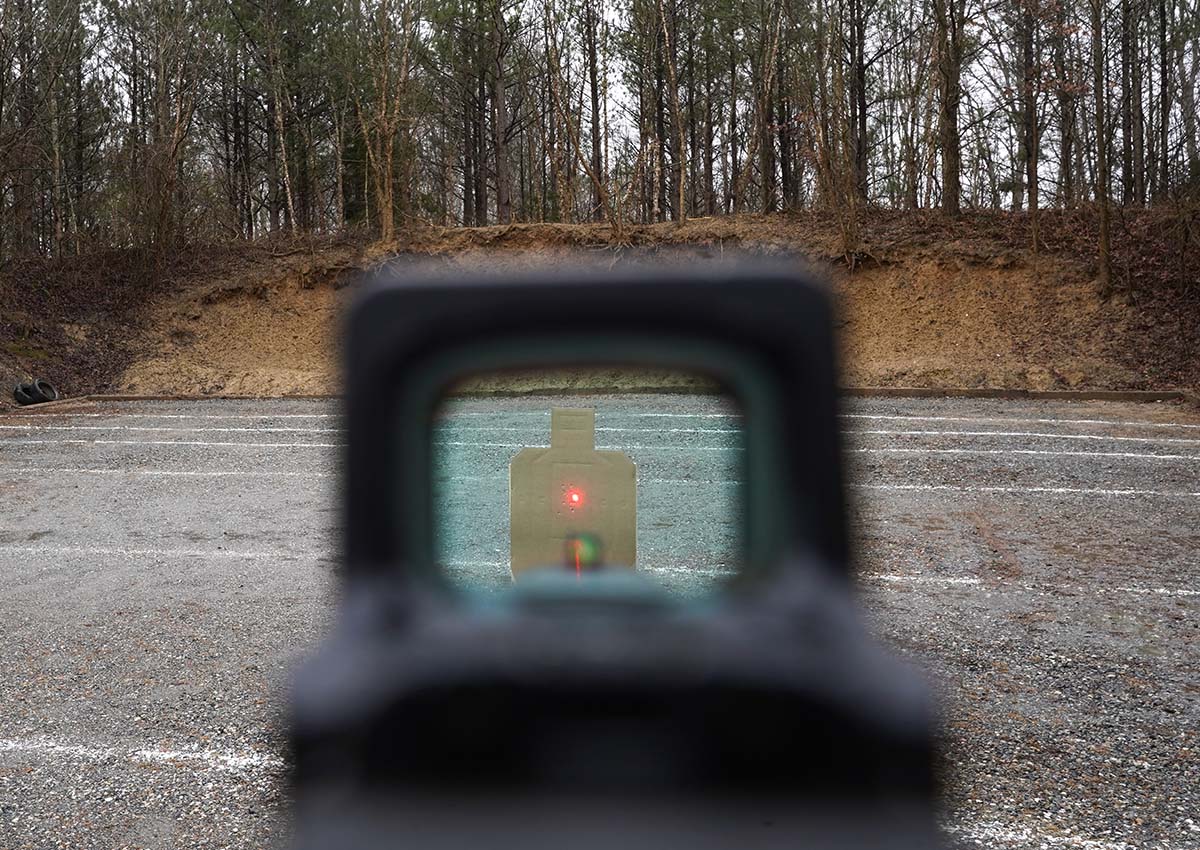
The Holosun EPS Carry mounts on guns with RMSc, Holosun K, Leupold DeltaPoint Pro, and Sig Sauer RomeoZero optic cuts or mounting plates. It comes with screws of various lengths (use the longest that will work) each with Blue Loctite already on them. Holosun recommends torquing the screws to 15 inch-pounds.
The battery door is located on the right side of the optic and is accessible without removing the red dot. Holosun says the battery life is 5,000 hours, which is about 200 days. It’s not the five-year battery life of the Holosun 507 K, but changing a battery once every six months is still pretty damn good.
The 6 moa dot on my EPS Carry is crisp and round. This is exactly how a dot should look, but many red dot sights come up short in this feature. The EPS Carry’s glass has a slight blue hue, which is common on red dots.
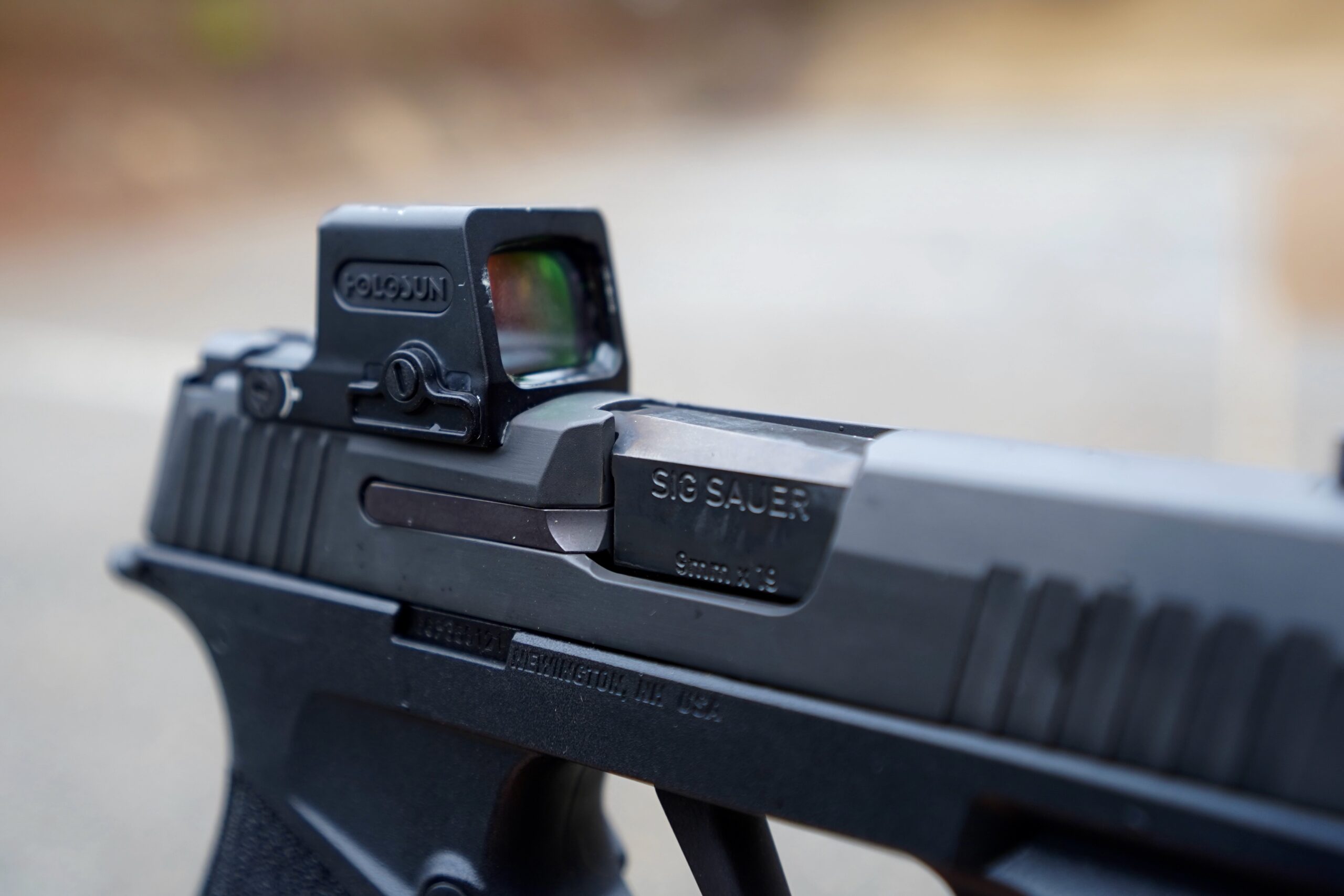
I slammed the front of the EPS Carry into my tailgate ten times to rack the slide on my empty XMacro. Then I dropped the unloaded gun from chest height so that it landed, red dot down, onto a gravel road. I picked up the handgun, loaded it, and confirmed my zero at 25 yards. The only evidence of this round of battery was some slight character marks on the housing. It held zero and functioned great throughout the rest of my range session. After a few hundred rounds, I repeated the test, and once again it was unfazed.
This isn’t a torture test meant to see if I could break the EPS Carry or to see if it’s worthy of use in the apocalypse. It’s a test that gives me confidence that if the optic takes a hard hit, it will keep its zero and continue working. -Scott Einsmann
Read the full Holosun EPS Carry review to learn more about the optic and see how it held up against the Trijicon RMR in a down pour.
Things to Consider When Buying a Red Dot Sight
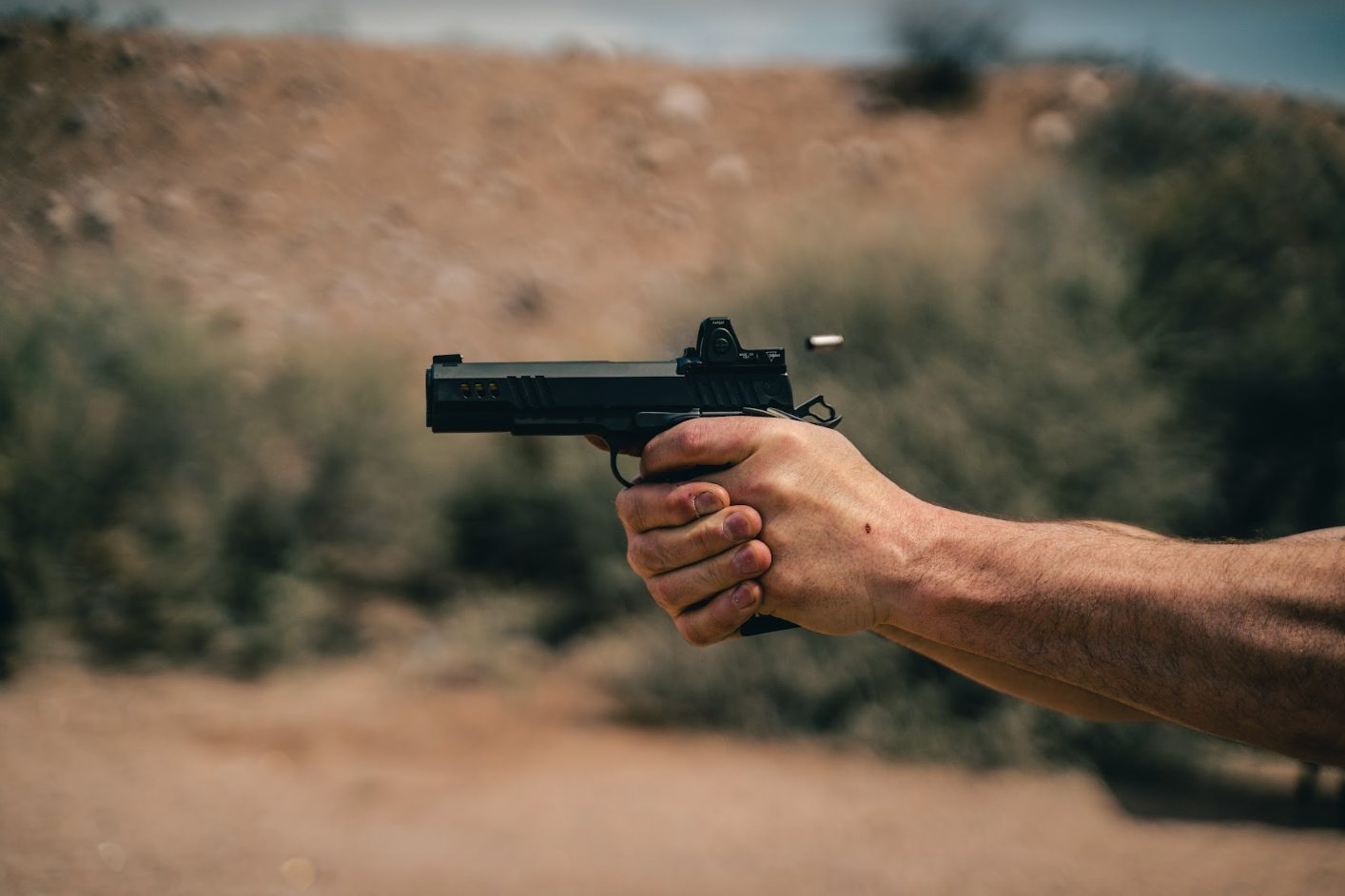
Red-Dot Skills
If you haven’t shot with a red dot, you will need to sharpen your skills. Shooting with a red dot sight seems intuitive, but there’s definitely a learning curve. Plan on doing a lot of dry-fire practice if you want to become proficient.
Mounting Red Dot Sights
Then there’s the matter of the different mounting standards, called “footprints.” There are numerous footprints out there and you can usually get a plate that will connect your specific firearm to a given red dot reflex sight, but be sure to do your research before buying one.
For the best handguns, some of the most common patterns include the Docter/Noblex, Trijicon RMR, and Shield.
Battery Life
Most red dots run on either CR 2032 or CR 1632 3-volt batteries. The run times you see published will range from a few hundred hours to several years. What to make of this? The fact is that battery life will vary depending on the reticle size and brightness setting you use, along with other factors. As a rule of thumb, you should swap out the batteries on your red dots once every year, just to keep them fresh and make sure they don’t conk out on you at an inopportune moment.
FAQs
There are plenty of high-quality red-dot sights on the market. The brand you gravitate toward depends largely on your budget and needs. Some of the best-known brands include Trijicon, Leupold, Aimpoint, Holosun, and Sig Sauer, all of which make excellent units. But don’t overlook Springfield Armory, Burris, Bushnell, Swampfox, and others.
You can get a basic, no-frills red dot sight for a little over $100, but as you open your wallet wider you will find sights with better features, improved ergonomics, and increased durability. For general range use, there are lots of sights costing $200 or less that will serve you well. But if you’re going to add a sight to a gun that you plan to use and carry on a daily (or near daily) basis, it makes sense to spend more if your budget allows. There’s a sweet spot for sights costing between $300 and $400 that are feature-rich, tough, and accurate. At the top end are sights costing nearly $600.
There’s no question about it. Trijicon red dot sights are among the most pricey out there. On top of that, if you compare them side-by-side with some cheaper red dots, you might think their optical quality isn’t as good. What gives? Well, the answer is that Trijicon’s red dots are built for use in battle and other life-and-death settings. They are engineered to higher standards of environmental toughness than most other red dots, they can be submerged in water at greater depths and for longer durations than most other red dots, and they have more sophisticated electronics and battery management systems. All these features add cost, but the end result are best-in-class sights.
It is possible to shoot very accurately with red dot sights, particularly if you use a finer aiming point like a 1 MOA dot. But even with a 2 MOA dot (or larger) a red dot can extend the accuracy of a handgun beyond what normal iron sights provide. For the best level of accuracy, choose a red dot that gives a clear crisp dot with minimal fuzz or flare around it.
The Navy SEALs and other units in the Special Operations community use a number of different sights depending on the weapon platform they are carrying. Among the sights used by SoCom are the Trijicon RMR Type 2, Leupold DeltaPoint Pro, as well as sights from Aimpoint, EOTech and Sig Sauer.
Laser sights have their place in certain applications, particularly in personal defense. While lasers are easy to use, they should never be relied on as the only sighting system for a handgun because there are a lot of circumstances where they won’t function—particularly in bright light. For this reason a red dot is the better option as a primary sight on a defensive gun, even though mastering a red dot takes practice.
Final Thoughts on the Best Red Dot Sights
The best red dot sights bring a lot of benefits. They increase accuracy at all ranges but they’re especially effective beyond 10 yards. Red dots make shooting on the move easier and they’re also helpful for shooters with aging eyes who have trouble keeping the front sight in focus. But to be effective with any red dot sight, you need to practice with it.
- Best Overall: Trijicon RMR Type 2
- Most Versatile: Burris Fastfire 4
- Best Budget: Crimson Trace CTS-1500
- Best Enclosed Emitter: Aimpoint ACRO P-2
- Best for Competitive Shooting: Trijicon SRO
- Lightest Weight: Sig Sauer Romeo Zero Elite
- Great Field of View: Sig Sauer Romeo1 Pro
- Best High-End Concealed Carry Sight: Trijicon RMRcc
- Best Micro: Swampfox Sentinel M
- Best Shotgun/Pistol Crossover: Holosun HE509T-RD
- Best Low Profile: Leupold DeltaPoint Micro
- Best for Fast, Close Shooting: Leupold DeltaPoint Pro 6 MOA
- Excellent All-Around Sight: Vortex Venom
- Ultra-Rugged: Steiner MPS
- Best for an AR-15 Pistol: USO DRS 2.0
- Best RMSc Enclosed Emitter: Holosun EPS Carry
